 Renata Gajoch-Bielecka
created
Renata Gajoch-Bielecka
created
10 Ways to build your own mailing list in B2B
Back to list of articlesAddress databases in B2B and B2C differ quite a bit, just like the processes used to gather recipient data. This is a result of the very different customer needs in each sector and the completely different approaches to communication that they use. Don’t know how to build your own mailing list in B2B? We’re going to take a look at the techniques that work best and the tools you will need to get started.

The needs of B2B recipients
It might seems like building an address database should always follow the same path. In both cases mentioned above it’s all about adding the most email addresses possible along with any extra information you can gather. But there are still important differences between them in terms of the needs and expectations of recipients and the places and methods involved in search for information about products and services. Recognizing these differences lets you create an effective strategy for building your own mailing list in B2B.
The B2B (Business to Business) is a sector comprised of services in which cooperation connects companies in order to provide services needed for the functioning of the market. In B2C (Business to Customer), companies provide services to the end customer. This difference should be the primary clue for where to start building your database.
The decision making process among B2B recipients is more meticulous than that of ordinary consumers. There are often more people involved than just the recipient of your newsletter. In fact, there can be as many as six people in different positions and responsible for different things in a company. There is also usually less subjectivity in the process in B2B customers. This means that B2B recipients typically evaluate your offer strictly on the basis of what it can do for their companies and how it can enhance their reputations as experts in their fields.
There can be as many as six people involved in decision making process in #B2B Click to Tweet
The decision making process in the B2B sector
Receipients in B2B take longer to make decisions than ordinary consumers. A poor purchasing choice in B2C doesn’t bring the potentially serious consequences - an expensive but faulty car only causes problems for the owner, not for an entire organization.
A report from CEB prepared in cooperation with Google shows that B2B decision makers take extra care in their decisions because mistakes can mean:
- a waste of time that will have to be explained
- a lost of trust and confidence as a specialist
- a fear of getting fired.
In the decision making process in B2B the individual needs of recipients correlate with the needs of the organization. Understanding the needs of both sides is the key to persuading new recipients to join your newsletter and creating effective email marketing messages. Remember that subscribers make the decision to sign up for your newsletter in the search for information that fills both rational and emotional needs as well as satisfying the expectations of the company he or she works for. Calls to action that appeal to emotions - “Join the best email marketers in the country” - should also interact with rational messages promising real benefits.
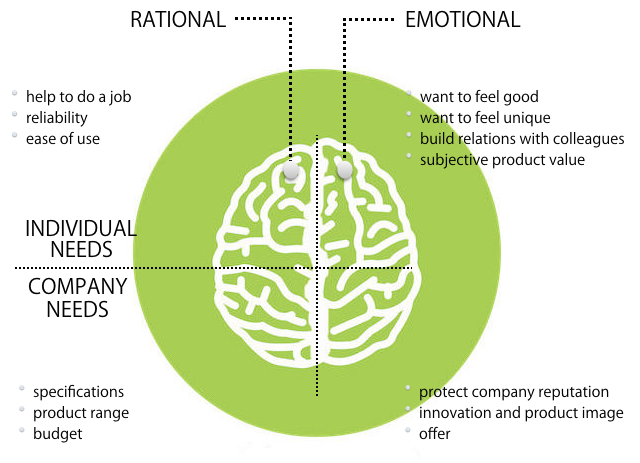
Your sign up form has to make a professional impression and make it clear that you deliver proven and valuable information. No B2B subscriber is going to waste time on anything less.
We know about the difference between the expectations between recipients in the B2B and B2C sectors. Now let’s put that knowledge into practice by getting leads wherever you can and getting the full potential out of the tools at your disposal.
Free methods
1. Work on your signup form on your website
The ability to find anything and everything on the internet completely changed the way we make purchasing decisions. According to CEB’s research, 60% of the decision making process takes place before any direct contact with a sales representative from the company.
ZMOT - Zero Moment of Truth - is the stage in the decision making process between becoming aware of a need and making a purchase and often takes place online. It involves a moment when your recipients are searching for information about possible solutions for the needs of their companies. They review offers, read opinions and develop their own impressions. This is when you have a great opportunity to get attention and promote your newsletter as a great way to learn more about you and your products.
Professional and effective sign up forms are essential tools for building your own database. Use our checklist to see if your sign up form has all the basic elements to maximize your conversion rate.

Remember that in B2B, offering access to exclusive materials and information is much more effective than things like rebates or discounts.
Pop-ups, and especially exit pop-ups (displayed when a visitor wants to leave your page or has spent a defined amount of time there) are one of the most effective ways to gain new additions to your address database. They have another advantage in that they can’t be ignored. You can’t miss a newsletter sign up form placed on a web page you are visiting. Rememeber, though, that you should cap the number of times a pop-up appears at 1 or 2 to avoid irritating visitors who have seen it and chosen not to join for now.
2. Use your official correspondence
Have you thought about how emails your company exchanged with potential customers last year? No? Take a minute and think about it and you will realize that what enormous potential those conversations have as a channel to build your own database. FreshMail has long used the footers of every employee to inform customers about new products and conferences we organize and a link to sign up for our newsletter. We can also use it to link everyone to our main site.

Using an internet generator lets you create personalized email footers that serve as sign up forms for your newsletter. It’s a great way for all the emails from your company to remind customers about the benefits of signing up. This kind of communication can be more effective in this situation than putting something on your web page, especially with business addresses.
3. Build your mailing list offline too
Meeting with potential customers during conferences, trade fairs and other events is a common assignment for many marketers. Not everyone knows that there is a great - and free! - way to biuld your database in such settings without the need for messy paper sign up forms.
FreshForm is a free tablet application for iOS and Android that lets you create professional sign up forms and synch new addresses to your mailing lists in FreshMail. You don’t need an internet connection for FreshForm, you can collect new subscribers anywhere, even outdoors. FreshForm makes it easy to add your logo to templates and tailor them to suit your needs. Just make the tablets easily accessible anywhere new customers might be and all new addresses will be automatically added to your subscriber database when you are back online.
4.Use content on your site to encourage new subscribers to sign up
Blog posts are one of the most popular type of content used to research B2B purchasing decisions. You can also effectively use the content of your blog to generate sign ups for your mailing list. There are two strategies for this:
- make the content available after sharing an email address,
- make the content available on your blog.
Examples for the first strategy include special reports, case studies, white papers and other materials that your subscribers can receive after they leave their email address on the sign up form. The most common way to complete this is to send new subscribers an email with a confirmation link in the double opt-in method in order to verify that the address belongs to them. This is the strategy that FreshMail uses with its annual Email Coding Report.
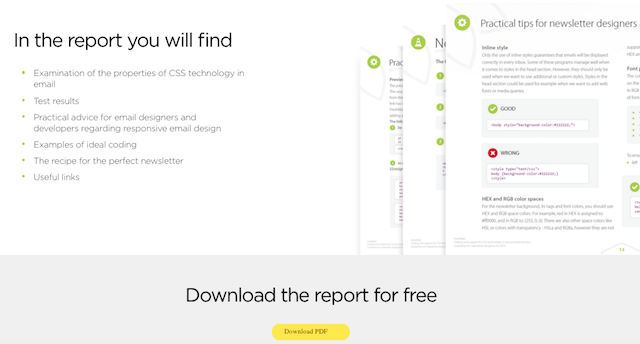
The second possibility is using dedicated plugins that allow subscribers to read fragments of posts. Acces to the full content of the posts is made possible only after leaving an email address in a sign up form.

5. Publish as a guest on other services and on expert blogs
Content marketing experts know that high value of unique business insights in the process of generating sales leads and building mailing lists. This is true even if you’re just starting out and don’t have much traffic on your blog yet.
There are many sites that will gladly publish your articles as long as they are not overtly advertising materials. Keep your content focused on the educational value, tips and advice for dealing with a specific challenge in your field. You can usually include links to your business or to your newsletter sign up form. This is a great way to generate interest and potential additions to your own subscriber database.
6. Let customers try out your solutions for free
Another interesting way to build your B2B database is to create dedicated tools that solve specific problems for subscribers. In exchange for using them you simply ask for an email address. A similar strategy is used by Sigstr, which makes tools available that generate personalized email footers. It allows use of a calculator that tells you how many messages your company generates and what kind of potential they have.
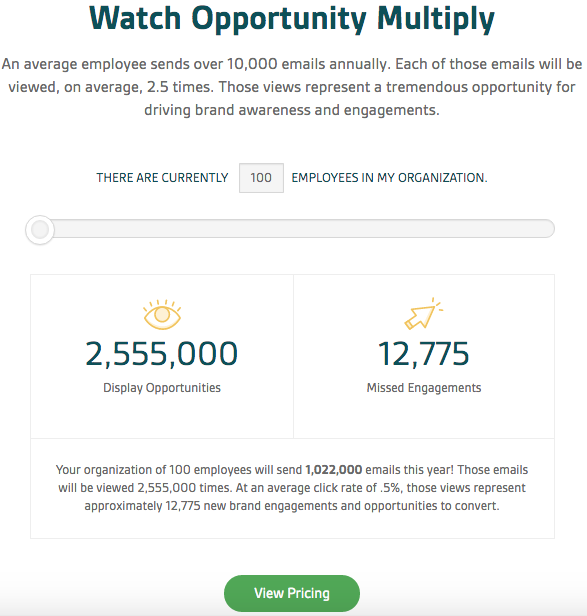
Source: Sigstr
You can use the same strategy for using demo versions of your products, which can be made available for a limited time in exchange for an email address. This doubles the benefit to you - not only do you get a chance to show potential customers what your tools can do and convert them into paying customers but you also have an email address that can be used to nurture leads in the future as well.
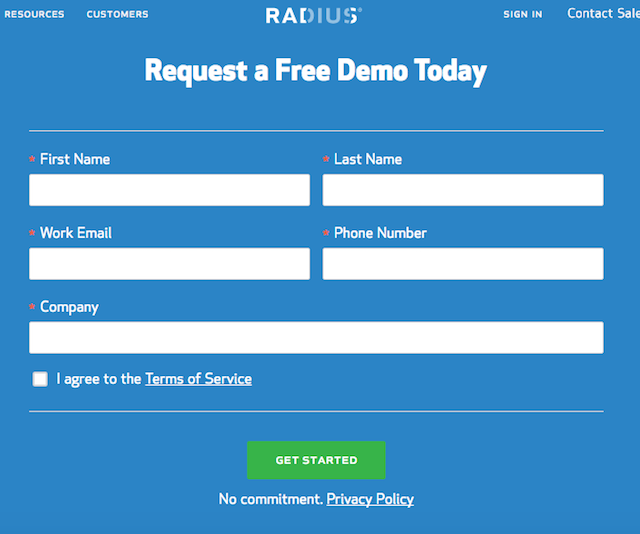
Source: Radius
7. Use QR codes
QR codes are small graphics that you can place on just about everything that serve to promote your brand. All customers have to do is scan it with a smartphone and they will be taken to, for example, a page with a sign up form for your newsletter. Use them wherever you can to spread the word about your newsletter. Remember that anyone who scans your QR code will be using a mobile device so your sign up form must be responsive in order to properly display on their screens.
Paid methods
8. Collect leads in social media
It’s likely that nearly all of your customers have social media pages. It’s easy to direct traffic to your fanpage to a newsletter sign up form and build your database. See how to set up a newsletter subscription form on your fanpage and collect new addresses for free.
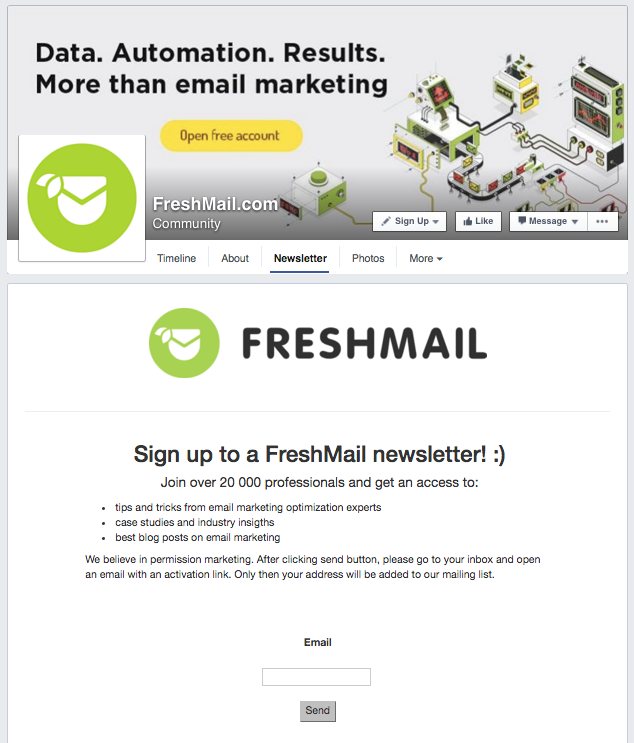
More possibilities for building your database using Facebook can also be found by using Lead Ads, which lets you place a sign up form in a sponsored post. This strategy makes reaching your target group easy since you choose the criteria for who sees your post - people who work in a certain field, participants in a certain event, etc. This ensures that you are getting addresses from subscribers that are part of your market. Be sure to include an enticement to sign up for your newsletter in the form of a case study, white paper or some other content that you share after getting an email address. You can also execute the same strategy on another social media giant by using Twitter Cards. If that’s where your potential customers are, then get started by creating your sign up form.
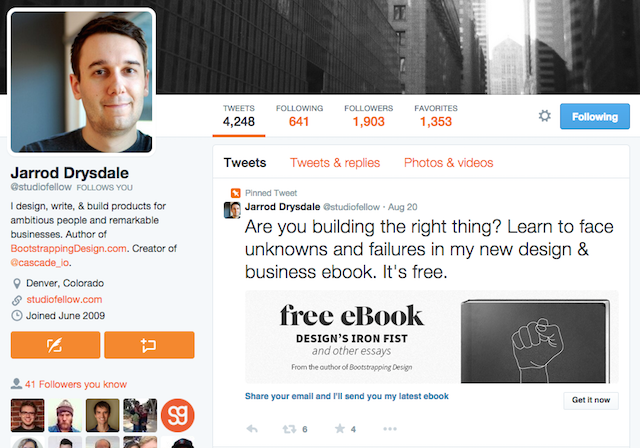
Source: Twitter, Jarrod Drysdale
Many professionals from various branches are also concentrated in Facebook groups. This has long been a platform for sharing knowledge and business experience between professionals in the B2B sector. The number of groups continues to grow and includes more branches and specialties all the time. As much as 40% of internet users mention brands in social media so you need to pay attention to this if building a subscriber database is your goal. It's enough to join a few groups associated with topics connected with your field to make contact with interested users. When you are able to help someone with a problem, suggest that they join your newsletter through your social media fanpage. This allows them to take advantage of the content of your newsletter and you add to your database in the process.

Source: Facebook, Shopify Ecommerce Group
Linkedin also offers opportunities to enhance your B2B subscriber list. You can use your own profile to take part in various groups and use special targeted messages sent directly to the inboxes of selected recipients. Linkedin is comparatively expensive but that is because it is regarded as the best platform for establishing business contacts. Remember that you don’t have to invest in advanced advertising projects. Sometimes good advice from a group or contact that you form with a decision maker can be the better way to go.
9. Send your message to an external base
Is it difficult for you to target potential customers because you operate in a wide field? No worries - there are solutions for everything! Trusted brokers and agencies specialize in sending emails to databases that they manage. This is the only time when using such an extrernal database is legal and consistent with email marketing good practices. Remember that buying B2B or B2C address databases is illegal and can result in significant financial penalties as well as severely damage your reputation as a sender, causing your future emails to be labeled as spam.
An experience and professional broker can help you choose the recipients that are right for you and ensure that your OR and CTR rates are as high as possible. Targeting is always important for maximizing the number of potential customers that you reach and who could be interested in signing up for your newsletter in exchange for their email address. If your newsletter delivers quality content that speaks to the needs and problems of consumers, you will find an audience for it. Unique content that helps recipients enhance their position in an organization, case studies or invitations to a conference will always be effective ideas.
10. Start a lead generation campaign with Adwords
Just like startups that test new business ideas, you can also use internet traffic to build your own mailing database. It’s enough to precisely identify who you want to attract to your landing page. Adwords campaigns give you unlimited possibilities and all you need to do is know how to find the consumers who find your message interesting.
To test the effectiveness of Adwords in building your database you can arrange to measure the conversion rate for signups to your newsletter. Adwords can place a link directly to your newsletter sign up form in the advertisement that you place online. Boost the effectiveness of your ad through remarketing. Since Google Analytics monitors your subscribers who also visit your web page, you can send them specific information that matches their interest in a particular part of your site. Add an invitation in the mail to join your newsletter with a mention of the content they can find there.
Again, the main and fundamental feature of any effective strategy for building your subscriber database is the ability to sense the needs of customers, where to find them and the persistence to keep building. Putting these all together lets you gain new addresses and subscribers anywhere and everywhere possible.

